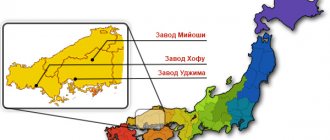Mazda is a brand famous throughout the world for its reliable, stylish and fast cars. Over almost a hundred-year history, a huge number of cars have been produced, the production of which has been established in many parts of the world.
The scale of the project can also be judged by the number of employees working for the company - their number is about 40 thousand, and the total turnover amounts to tens of billions of dollars per year.
Where are Mazda cars made? Are there factories in Russia, and how high-quality a product do they produce? Let's consider these points in more detail.
Foundation of the company
The president of Mazda became Jujiro Matsuda, whose father was a poor fisherman, so he did not own much money. Matsuda did not start the company from scratch. Initially, the concern did not belong to him - the bankrupt construction company was bought together with investors.
Mazda President Jujiro Matsuda
Jujiro Matsuda's life has not been easy. He did not have the opportunity to study at school, so he had to take up blacksmithing. It helped Matsuda realize his passion for the automobile industry. Before the future engineer became the owner of his own concern, he worked at many enterprises. Among them were shipyards and weapons factories.
After the company was founded, its specialists worked on motorcycles for 10 years. Alas, production never became widespread. Machine tools continued to be the main focus.
History of the emblem
The Mazda logo did not appear immediately after the company was founded. It first saw the light of day after 1934. The Mazda logo was a stylized name of the company. Then the brand logo became more minimalistic. Now it looked like the letter M. The second Mazda logo appeared 2 years after the first.
History of the Mazda logo
The next logo update occurred in 1962. The letter M was placed in a circle. And in the period from 1975 to 1991, the company did not have an official emblem. It was only in 1991 that a new design was developed, and it is this Mazda sign that the company uses now, although in a slightly modified form.
The meaning of the Mazda icon is fire or sun. On it you can see the sun itself, a circle of light and wings. It is because of the wings that the logo is often compared to an owl. Mazda was recognized with the old badge, but the new one became the most original and acquired cult status.
Mazda name meaning
The company became familiar with its name only in 1931. The Mazda brand is named after the Zoroastrian god Ahura Mazda, who was worshiped as the god of wisdom. Also, the name is similar to the surname of the founder and is pronounced similar.
Brand philosophy
In many ways, the philosophy of the brand is determined by its country of origin - Japan. Now the history of the manufacturer goes back a century. The personal story of the brand's creator, Jujiro Matsuda, has been and remains the main pillar of Mazda's philosophy.
The classic Mazda body shape has not changed for several decades
Mechanical engineering was not just a way to make money. Manufacturing vehicles is Matsuda's true passion. He believed that technology is a way to change the world for the better, and this attitude marked the vector of development for his company.
Japan is a country of innovation and inventors, so the desire for continuous development is in the Japanese blood. Part of their tradition is to do their work conscientiously, so there is no doubt about the quality of the product, it is always at the highest level.
The Japanese do not forget about beauty, so Mazda designers created their own style called Kodo. The name means "soul of movement". All cars of the company not only technically, but also externally embody power and speed.
Activity
Personal experience Mazda CX-5 1st generation
Mazda's two main factories are located in Japan (in the cities of Hiroshima and Hofu), and 18 additional ones are located outside of Japan. The company's production volume in 2010 amounted to 1,307,540 units, which is 32.8% higher than the level of 2009. Revenue in the fiscal year ending March 31, 2010 was $23.3 billion, but during the same period the company's losses amounted to about $80 million.
Mazda in Russia
On June 21, 2011, Mazda signed an agreement with the Russian Ministry of Economic Development on the industrial assembly of cars, providing for the creation of a car assembly plant in the Primorsky Territory.
In April 2012, Mazda and Russian automaker Sollers signed an agreement to create a joint car assembly plant in Vladivostok. A joint venture (JV) was created, where the partners received equal shares. Already in September, the opening ceremony of the new joint venture Mazda Sollers Manufacturing Rus LLC took place. Serial production was launched in October 2012. At the first stage, the joint venture will produce two car models: the Mazda CX-5 crossover and the new Mazda 6 sedan. The production capacity of the enterprise will be 50 thousand cars per year, the design capacity is 100 thousand cars.. Assembled cars will be sold through the Mazda dealer network throughout Russia.
In September 2021, MSMR and the Ministry of Industry and Trade of the Russian Federation signed a special investment contract for the construction of a Mazda engine plant in Vladivostok. The volume of investments amounted to 2 billion rubles. According to the document, the responsibilities of the joint venture included mastering the production of updated versions of the Mazda 6, Mazda CX-5, Mazda CX-9 and creating at least 600 jobs.
In 2021, it received the status of resident of the Nadezhdinskaya ASEZ. After that, in the fall of 2021, the joint venture began construction of a plant for the production of Mazda Skyactiv-G engines.
On September 10, 2021, Sollers and Mazda opened an engine production plant in Vladivostok on the territory of the joint venture. The engine plant specializes in the production of four-cylinder gasoline engines meeting the Euro-5 environmental standard. The design capacity of the plant is 50 thousand units per year. The total area is 12.6 thousand m2. On the territory of the plant there is an engine production shop, a cylinder head machining shop, an internal logistics area and an administrative building.
Development of the Japanese automobile industry
The company did not immediately start producing transport. Initially it was a construction company. Her specialization was the creation of balsa wood panels, and later the production of machine tools was launched. In 1925, the factory that Matsuda owned burned down. As a result, it was decided not to return to the old products; instead, the plant was repurposed to produce vehicles. The first vehicles produced by the updated plant were motorcycles.
Military motorcycle "Mazda"
Earlier in 1923, a powerful earthquake occurred in Japan. It hit the economy, and the country's residents could not afford expensive means of transportation. This meant that the use and sale of budget wheeled vehicles became relevant. It was then that the company developed a range of three-wheeled motorized trolleys. They were easy to produce and affordable, so they were a success.
In 1931, the concern's first car appeared on the Japanese market. This model was a truck. Sales were excellent, so it was decided to export to China.
The company's factories were completely destroyed when bombs were dropped at the end of World War II. But the company still returned to the market. It continued to produce quality trucks.
- In 1967, the concern amazed everyone by introducing the Cosmo Sport 110S sports car. Before that, in 1964, they released a car for the whole family, the Mazda Familia. The business expanded, products were already imported to 20 countries.
- In 1981, a significant event occurred - entry into the American market.
- 1986 was marked by the release of the RX-7 model.
- The year 1989 was notable for the announcement of one of the most popular cars of the brand - the MX-5 convertible.
In 2000, Mazda made a breakthrough by starting to interact with customers via the Internet. But network marketing is not the only achievement. In 2002, the Sports F model was released. Its uniqueness is that it was developed by women.
Where is Mazda 3 assembled, are there factories in Russia?
Mazda 3 is a compact car developed by Mazda Motors. In Japan it is called "Axela". It is exported under the names Mazda 323 and Prot?g?.
Already in 2009, a new (second) generation of the Troika appeared on the market, and two years later its restyled version appeared. In 2013, the 3rd generation car entered the market.
Despite the fact that the model has been successfully sold for more than ten years, production in Russia started relatively recently.
So, in 2013, we managed to launch a full-fledged assembly of the 3rd series at a plant in Vladivostok.
The most affordable package was Drive, which comes with 1.5 and 2.0 liter engines, 6-speed automatic transmission, as well as 4 or 6-speed manual transmission.
Mazda 3, manufactured in Russia, is distinguished by an improved suspension, higher ground clearance, better sound insulation, adapted for operating the car on the roads of the Russian Federation.
There was a “fly in the ointment”. Mazda connoisseurs criticized the domestic version from the standpoint of the body.
The main problem was the metal, which was susceptible to corrosion and was too thin.
The Russian version of Mazda quickly becomes covered with rust and forces car owners to spend money on restoration, carrying out anti-corrosion treatment of the body.
Mazda's place and prospects now
Today the company successfully produces a wide variety of cars, including crossovers and concept cars. Mazda tries very hard to be accessible to most people. For this reason, the concern almost completely abandoned the development of luxury cars and focused on producing small and middle class cars. A special line of products is also being developed – sports cars.
The most popular sports car model "Mazda 6"
Mazda exports to 120 countries, and the company owns assembly plants in 21 countries. Recently, in accordance with the latest trends, the first electric car developed by the company's engineers was released.
Determining the country of assembly by VIN
Decoding the vin code of the CX-5
According to established requirements, each manufacturer is required to apply a VIN number . It is a combination of letters and numbers , which carries information about the car, technical characteristics, and equipment. The number is duplicated in the following places :
- in the central part of the motor space;
- on the doorway pillar;
- in the area of the passenger's feet;
- under the windshield and hood cover on the body.
Mazda 6s are produced in different countries with specific VIN codes. To determine whose assembly you should look at the first characters of the VIN number :
- 1YV – USA;
- JMZ – Japan;
VIN number of GJ assembled in Japan. - LMZ – China;
- RUMGJ - Russia.
VIN number of Mazda GJ assembled in Russia.
In Russia, Mazda 6 has two VIN numbers. Accordingly, one is Russian, and the second is Japanese.
Mazda's luxury brand – Amati
The refusal to produce premium cars is easy to explain. Amati was prepared primarily for the American market, and the car was supposed to go on sale in 1983 in both the USA and Japan. The model was impeccable in all respects and met luxury standards. But this did not save her from failure.
It was decided to change course and sell most of the cars at home, but it was then that an economic crisis occurred in Japan, and middle-class cars were more relevant. So the car was not successful, but became a pillar for further developments.
Mazda 6 configurations
The debut of the Russian-assembled Mazda 6 was the Active package. It received a gasoline engine with a volume of 2.5 liters and a power of 192 horsepower. The model has front-wheel drive, and the transmission has become automatic. You will also get climate control and active safety systems. The car will cost from 925,000 rubles. Total investments in production amounted to 10 billion rubles.
Two configurations were also produced here, which were not produced this year. Therefore, we will not mention them.











